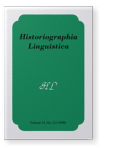From pragmatics to semiotics
The influence of John Wilkins’ pulpit oratory on his philosophical language
John Wilkins’ (1614–1672) earlier work on pulpit oratory in Ecclesiastes (1646) and Gift of Prayer (1655) provide a rationale for his later work on philosophical language in his Essay towards a Real Character (1868). Clauss (1982) pointed out that one could view Wilkins’ linguistic writings as compatible, and the present paper advances her argument by showing that his work on philosophical language grew out of his work on pulpit oratory. Moreover, his pulpit oratory is rooted in pragmatics – how to move the listener to righteous action – while his philosophical language is focused on semiotics – how to convey the ‘true meaning’ of all things and notions.
References
Aarsleff, Hans
1976 “
John Wilkins (1614–1672): A sketch of his life and work”.
Dictionary of Scientific Biography ed. by
Charles C. Gillispie, vol.XV1, 361–381. New York: Scribner’s. (Repr. in
Subbiondo 1992.3–44.)

Beale, Walter H.
1987 A Pragmatic Theory of Rhetoric. Carbondale: Southern Illinois Univ. Press.

Christensen, Francis
1946 “
John Wilkins and the Royal Society’s Reform of Prose Style”.
Modern Language Quarterly 71.179–187, 279–290. (Repr. in
Subbiondo 1992.133–154.)



Clauss, Sidonie
1982 “
John Wilkins’ Essay Toward a Real Character: Its place in the seventeenth-century episteme”.
Journal of the History of Ideas 421.531–553. (Repr. in
Subbiondo 1992.45–68.)


Fisch, Harold & Harold W. Jones
1951 “
Bacon’s Influence on Sprat’s ‘History of the Royal Society’”.
Modern Language Quarterly 121.399–406.


Foucault, Michel
1972 The Archaeology of Knowledge. Transl, by
A. M. Sheridan Smith. New York: Pantheon.

Hill, Christopher
1965 Intellectual Origins of the English Revolution. Oxford: Oxford Univ. Press.

Hill, Christopher
1975 Change and Continuity in Seventeenth-Century England. Cambridge, Mass.: Harvard Univ. Press.

Howell, Wilbur Samuel
1956 Logic and Rhetoric in England 1500–1700. Princeton, N.J.: Princeton Univ. Press.

Jones, Richard F.
1930 “
Science and English Prose Style in the Third Quarter of the Seventeenth Century”.
PMLA 451.977–1009.


Jones, Richard F.
1932 “
Science and Language in England of the Mid-Seventeenth Century”.
Journal of English and Germanic Philology 311.315–331.

Salmon, Vivian
1972 The Works of Francis Lodwick: A study of his writings in the intellectual context of the seventeenth century. London: Longman.

Salmon, Vivian
1979 The Study of Language in 17th Century England. Amsterdam: John Benjamins (2nd. ed. 1988.)

Shapiro, Barbara J.
1969 John Wilkins 1614–1672. Berkeley: Univ. of California Press.



Shapiro, Barbara J.
1983 Probability and Certainty in Seventeenth-Century England: A study of the relationships between natural science, religion, history, law. and literature. Princeton, N.J.: Princeton Univ. Press.

Slaughter, Mary M.
1982 Universal Languages and Scientific Taxonomy in the Seventeenth Century. Cambridge: Cambridge Univ. Press.

Subbiondo, Joseph L.
1977 “
John Wilkins’ Theory Meaning and the Development of a Semantic Model”.
Cahiers Linguistiques d’Ottawa 51.41–61. (Repr. in
Subbiondo 1992.291–308.)

Wilkins, John
1646 Ecclesiastes, or a Discourse of the preaching as it falls under the rules of art. London: Samuel Gellibrand.

Wilkins, John
1655 A Discourse concerning the Gift of Prayer Shewing What it is, wherein it consists and how far it is attainable by Industry with divers, useful, and proper directions to the purpose, both in respect of Matter, Method, and Expression. London: Samuel Gellibrand.

Wilkins, John
1668 An Essay towards a Real Character, and a Philosophical Language. London: Samuel Gellibrand & John Martyn.

Cited by
Cited by 1 other publications
This list is based on CrossRef data as of 3 july 2024. Please note that it may not be complete. Sources presented here have been supplied by the respective publishers.
Any errors therein should be reported to them.
